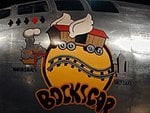FLYBOYJ
"THE GREAT GAZOO"
B-32 SPECIFICATIONS
Span: 135 ft. 0 in.
Length: 82 ft. 1 in.
Height: 32 ft. 2 in.
Weight: 100,000 lbs. (design gross weight)
Armament: Ten .50-cal. machine guns plus 20,000 lbs. of bombs (max.)
Engines: Four Wright R-3350-23 Cyclone radials of 2,200 hp. each (takeoff power)
Crew: 10
PERFORMANCE
Maximum speed: 357 mph. at 30,000 ft.
Cruising speed: 290 mph.
Range: 3,000 miles w/ 10,000 lbs. bomb load
Service Ceiling: 30,700 ft.
Compared to the B-29....
Span: 141 ft. 2.76 in.
Length: 99 ft. 0 in.
Height: 27 ft. 9 in. (at rest) 27 ft. 6.7 in. (taxi position)
Weight: 133,500 lbs. (max. overload) 105,000 lbs. gross
Armament: Ten or twelve .50-cal. machine guns and one 20mm cannon plus 20,000 lbs. of bombs.
Engines: Four Wright R-3350-21 or -23 "Cyclone" radials each equipped with two type B-11 turbo superchargers.
PERFORMANCE
Maximum speed: 357 mph at 25,000 ft.
Cruising speed: 220 mph
Range: 5,600 miles max. ferry range and 3,250 miles with 20,000 lbs. of bombs
Service Ceiling: 33,600 ft.
Only 75 were built. Cancellation of the B-32 program came on 8 September 1945 and production of Dominators was halted on 12 October. Flyable aircraft at Consolidated factories were flown directly to the scrap yard and all partially built B-32s were scrapped at the factory. The last remaining B-32 was scrapped in the summer of 1949.
This aircraft was supposed to replace the B-17 and B-24 had the war lasted longer and had it got delivered earlier (it was well over a year behind schedule). General Kenny, Commander of the 5th AF also wanted the plane after the 5th AF was denied B-29s. One Squadron, the 386th Bomb Squadron, 312th Bomb Group, 5th Air Force got 3 of them and flew 6 missions before the end of the war. One B-32 even got damaged by flak and fighters.
Do you think this aircraft could of replaced both the B-17 and B-24? How do you think it would of done over Germany, especially aganist the ME-262? Keep in mind that this aircraft did not use remote control radar gun turrets like the B-29 but rather electric manned turrets like the B-17 and B-24.
Span: 135 ft. 0 in.
Length: 82 ft. 1 in.
Height: 32 ft. 2 in.
Weight: 100,000 lbs. (design gross weight)
Armament: Ten .50-cal. machine guns plus 20,000 lbs. of bombs (max.)
Engines: Four Wright R-3350-23 Cyclone radials of 2,200 hp. each (takeoff power)
Crew: 10
PERFORMANCE
Maximum speed: 357 mph. at 30,000 ft.
Cruising speed: 290 mph.
Range: 3,000 miles w/ 10,000 lbs. bomb load
Service Ceiling: 30,700 ft.
Compared to the B-29....
Span: 141 ft. 2.76 in.
Length: 99 ft. 0 in.
Height: 27 ft. 9 in. (at rest) 27 ft. 6.7 in. (taxi position)
Weight: 133,500 lbs. (max. overload) 105,000 lbs. gross
Armament: Ten or twelve .50-cal. machine guns and one 20mm cannon plus 20,000 lbs. of bombs.
Engines: Four Wright R-3350-21 or -23 "Cyclone" radials each equipped with two type B-11 turbo superchargers.
PERFORMANCE
Maximum speed: 357 mph at 25,000 ft.
Cruising speed: 220 mph
Range: 5,600 miles max. ferry range and 3,250 miles with 20,000 lbs. of bombs
Service Ceiling: 33,600 ft.
Only 75 were built. Cancellation of the B-32 program came on 8 September 1945 and production of Dominators was halted on 12 October. Flyable aircraft at Consolidated factories were flown directly to the scrap yard and all partially built B-32s were scrapped at the factory. The last remaining B-32 was scrapped in the summer of 1949.
This aircraft was supposed to replace the B-17 and B-24 had the war lasted longer and had it got delivered earlier (it was well over a year behind schedule). General Kenny, Commander of the 5th AF also wanted the plane after the 5th AF was denied B-29s. One Squadron, the 386th Bomb Squadron, 312th Bomb Group, 5th Air Force got 3 of them and flew 6 missions before the end of the war. One B-32 even got damaged by flak and fighters.
Do you think this aircraft could of replaced both the B-17 and B-24? How do you think it would of done over Germany, especially aganist the ME-262? Keep in mind that this aircraft did not use remote control radar gun turrets like the B-29 but rather electric manned turrets like the B-17 and B-24.





